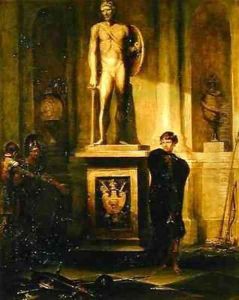Sir Francis Bourgeois Paintings
Sir Francis Bourgeois was an esteemed British painter, primarily known for his landscape paintings and for his significant contribution to the public appreciation of art through his bequest that led to the founding of the Dulwich Picture Gallery. Born in November 1753 in London to Swiss parents, Bourgeois's early life set the stage for a career that would be both artistically innovative and philanthropically impactful.
Despite the early death of his father, Bourgeois received a good education and developed an interest in painting from a young age. His artistic talents were nurtured under the guidance of Philip James de Loutherbourg, a renowned landscape painter of the time, who was influential in shaping Bourgeois’s early style and approach to landscape art. Bourgeois's work soon gained recognition, and he became a respected figure within the London art scene. His paintings, which often depicted dramatic landscapes and battle scenes, were characterized by their vivid detail, dynamic compositions, and emotional depth.
Bourgeois was not only a painter but also a savvy art collector and dealer, which enabled him to amass a considerable fortune over his lifetime. His success as an artist led to his appointment as a Painter to the King for King George III, and he was later knighted, which was a significant honor that acknowledged his contributions to the arts.
One of Bourgeois's most lasting legacies is his philanthropic contribution to the public's access to art. Upon his death in January 1811, he bequeathed his collection of paintings, along with funds to build a gallery to house them, to the people of Dulwich for the purpose of founding a public gallery. This led to the creation of the Dulwich Picture Gallery, one of the first public art galleries in England. The Gallery not only served as a home for Bourgeois’s own works and collection but also played a crucial role in democratizing access to art, setting a precedent for future public galleries and museums.
Throughout his life, Sir Francis Bourgeois was driven by a passion for art and a belief in its ability to enrich the public sphere. His contributions to landscape painting and his visionary approach to public art access have cemented his place in British art history. The Dulwich Picture Gallery remains a testament to his artistic legacy and philanthropic vision, continuing to inspire and educate the public on the value and beauty of art.
